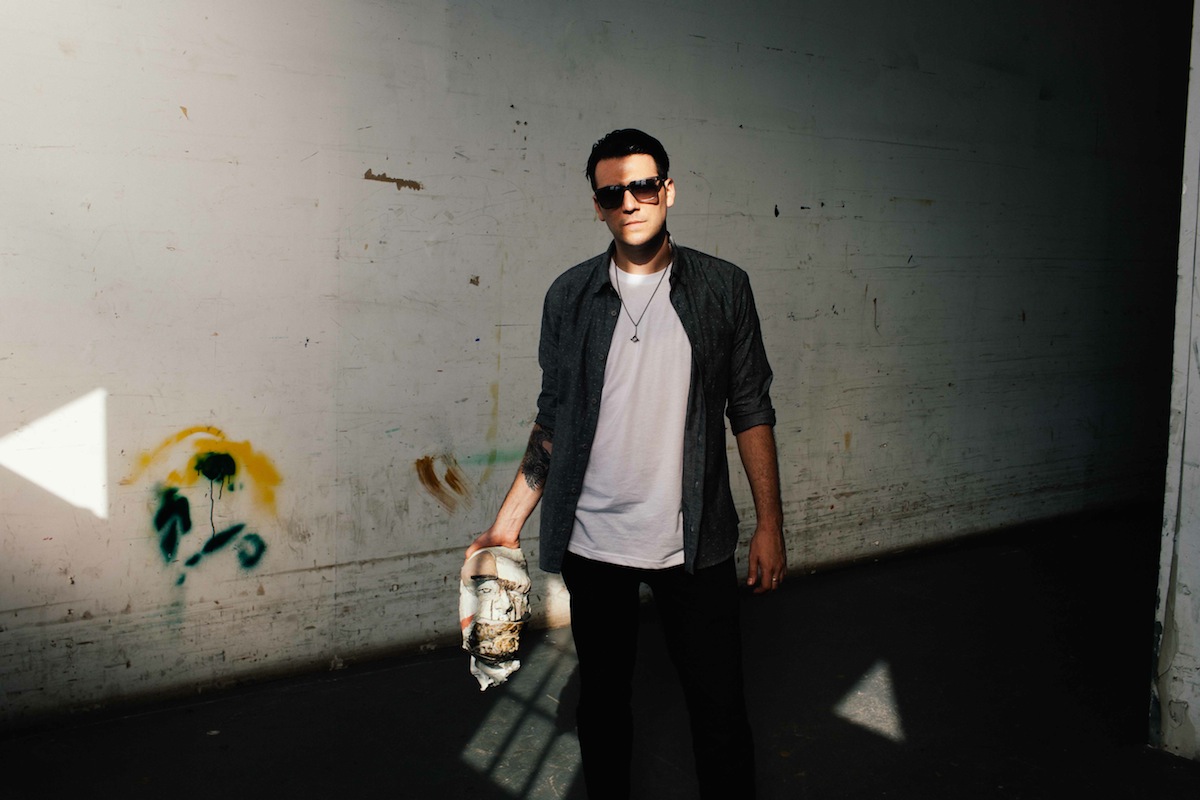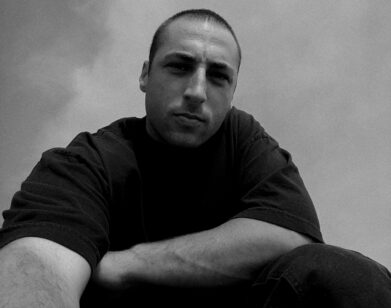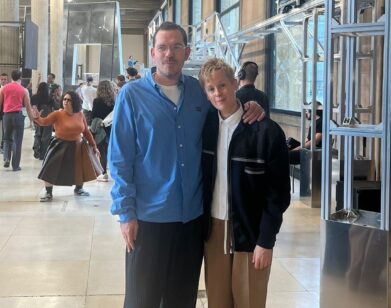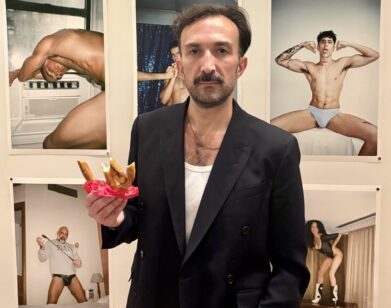Sculpting Derek Weisberg
You might think dead rappers and ancient Egyptian canopic jars don’t have much in common. But one of sculptor Derek Weisberg’s many accomplishments has been melding these two very different things he’s passionate about—hip-hop and ancient Egypt—into unique works of art. “It’s my way of immortalizing legendary rappers,” notes Weisberg. Hailing from the Bay Area, Weisberg—who is now based in Brooklyn, New York—also names classic Roman sculpture, the art of Egon Schiele, and Bay Area artistic movements as sources of inspiration: “I have so many points of reference,” he says.
After graduating from the California College of Arts and Crafts, Weisberg has worked as a full-time artist for the past 10 years and honed his skills under the late legendary sculptor Stephen De Staebler. Weisberg primarily creates figures, busts, masks, jars, hands, and wall reliefs—sometimes even reaching eight feet tall—all by hand. Themes such as death, vulnerability, human dysfunction, longing, and loss come through in his pieces. While Weisberg’s sculptures are highly recognizable for their stylized and detailed look, he’s recently shifted gears, exploring how clay can be used in non-traditional ways. We chatted with Weisberg about his upcoming fashion and music collaborations, the transformation of his artistic style, and his thoughts about why ceramics are seeing a modern-day revival.
VICTORINE LAMOTHE: You’ve been doing ceramics for over 20 years. How did you get into it?
DEREK WEISBERG: I started working with clay when I was seven years old, because my parents saw that I liked making things. My mom even used to say that I liked to sculpt my mashed potatoes at the dinner table. So they enrolled me in a local ceramics class and I really loved it. The teacher recognized my focus, even at that young age.
LAMOTHE: You then went to the California College of Arts and Crafts in Oakland, California. You must have known at a young age that you wanted to be an artist.
WEISBERG: I pretty much knew in my junior year of high school that I wanted to be a full-time ceramics artist. Before that I thought I might have been a sculptor for movie sets, but I went to a summer program at Cal Arts and it completely changed my perspective. After that, I realized that I didn’t want to make other peoples’ ideas. I wanted to execute my own.
LAMOTHE: How has your work changed over the years?
WEISBERG: Lots of things can happen that affect your work. You change studios. You have access to different facilities. The most recent change happened about a year and a half ago when I started reevaluating what I made. I began questioning why I created things and what it means to have a signature style. I had to examine what defined a typical “Derek Weisberg sculpture.”
LAMOTHE: What are the elements that make up a “Derek Weisberg sculpture”?
WEISBERG: Very stylized figurations. Sculptures that are refined, naturalistic, and detailed.
LAMOTHE: What exactly changed during your period of evaluation, then?
WEISBERG: I let go of the stylization and the refinement. Things are a lot more abstract now. I was still interested in the same ideas—like vulnerability or human dysfunction—but the execution changed.
LAMOTHE: What was that like?
WEISBERG: Really hard! So much of what you make as an artist is tied to your identity. I wanted to let go of all of that because my work felt very redundant. I’d go into the studio and do the same thing over and over again. So I started telling myself to try and make sculptures like I never did before.
LAMOTHE: You’ve recently been making figures out of broken pieces of clay glued together.
WEISBERG: Yes, that’s one example. They are very collage-like.
LAMOTHE: A lot of your sculptures look like death masks. What’s that about?
WEISBERG: I consciously wanted to make death masks—I’m fascinated by them. I also really love funerary effigies and how they honor individuals. I like the rituals that are associated around death.
LAMOTHE: Why is that?
WEISBERG: I’ve personally experienced a lot of death. My mom passed away eight years ago, when I was 24. So did an artist I worked with for seven years named Stephen De Staebler. He was my role model. Because of those experiences I realized how complex of a situation death is and how lost you can be within that. Ritual exists because it gives you a template to react within.
LAMOTHE: How do rituals influence your work?
WEISBERG: One example is that series of Egyptian-inspired canopic jars of dead rappers I did two years ago. In the mummification process the ancient Egyptians would take out important organs and put them in these jars, which were then guarded by gods.
LAMOTHE: Why did you decide to depict dead rappers with canopic jars?
WEISBERG: I listen to rap music about 95 percent of the time, whether it’s in my studio or in the subway. I feel like it’s a part of what makes up my identity. It’s my way of celebrating rappers like the Notorious B.I.G, Tupac, Eazy-E, and Guru.
LAMOTHE: Your studio is located in Bushwick, Brooklyn. How do you feel about being an artist in New York—and especially Bushwick, which is very saturated with artist studios?
WEISBERG: I don’t feel too threatened, because I believe my work is fairly distinct. I feel a bit isolated or alienated sometimes, though. New York is a big place with a lot of people. In the Bay Area, it was easy to feel like a big fish in a small pond. But once I get in my studio and close the door, I forget about all of that. At the end of the day, none of it matters. All that matters is that you’re in the studio working.
LAMOTHE: When you’re working on a particular sculpture, how do you generally approach the project?
WEISBERG: Basically I show up to the studio every day. Even if I don’t know what I’m going to do, I show up, sit down, and look around. Before I know it, I become activated. My mind starts turning, and then I know what to do.
LAMOTHE: Clay is a very physical material to work with. Do you ever get physically tired?
WEISBERG: Not anymore—I’m used to it now, but it’s definitely physical. You’re rolling it out, pinching it, working it. That’s something I love about the material. With clay, there’s an intimacy and directness that I find very beautiful.
LAMOTHE: Ceramics has been seeing something of a resurgence, and a lot of people are enrolling in pottery and sculpting classes. Why do you think that is?
WEISBERG: That’s a good question! Clay really is the material du jour. One reason is that for a long time clay was pigeonholed as a material of craft and functionality. Today people are realizing that you can make fine art with it. I also think that there’s something about that handmade aspect of it. It’s a process that people really like.
LAMOTHE: You’ve partnered with the Brooklyn-based menswear boutique Goose Barnacle for a solo exhibition, and you’re currently preparing for an event featuring a hip-hop violinist. How did that come about?
WEISBERG: David Alperin, the store’s owner, organized my solo exhibition and regularly puts on art shows there. It’s running through October, and one of the events during its run will be a concert with a hip-hop violinist called Matt the Violinist on October 23rd. It was organized through the Eastman Collective—a two-person team that curates art shows—along with Quiet Lunch Magazine.
LAMOTHE: You have another show at a clothing boutique in Los Angeles.
WEISBERG: Yes, it’s opening September 25 and will be held at a fashion boutique called Church. It’s another place that’s fusing art, fashion, and design. I’ll be showing six sculptures and around seven masks there.
LAMOTHE: Why do you like collaborating with fashion boutiques?
WEISBERG: I enjoy presenting my work in multiple contexts. The white walls and clean environment of a traditional gallery is great but sometimes sterile. Showing my sculptures in a clothing store can let you see what they look like with other objects. I also like the cross-pollination of different creative areas. In today’s Internet age, everything is getting mashed up together. It’s really smart for artists to present their work with other practices. Raf Simons and Sterling Ruby worked on a fashion-art collaboration together. Jay Z performed rap in Pace Gallery. Kanye West and Lady Gaga are doing art meets music meets fashion. It’s an interesting time for blending creative genres.
LAMOTHE: What are your goals for the future? What are you looking to accomplish in your artistic career?
WEISBERG: Of course I have big hopes of having more solo shows and museum exhibitions. I’d also love to do large-scale pieces that are tied to performance. But ultimately I’d like to be continually curious. Excited every morning to go to my studio and make stuff.
DEREK WEISBERG’S WORK IS CURRENTLY ON DISPLAY AT GOOSE BARNACLE IN BROOKLYN AND WILL BE ON DISPLAY AT CHURCH IN LOS ANGELES STARTING SEPTEMBER 25.







